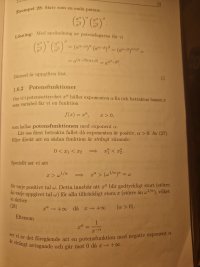The only Swedish I remember from my one week in the country decades ago is that all
street names end with ``gatan'', but here are my two öre's worth:
First, replace (26) with an equivalent statement, [math]a > 1 \wedge \gamma > 0 \Longrightarrow a^\gamma > 1[/math].
My logic is a little rusty, I think your statement is equivalent, for if we substitute [imath]\alpha=0[/imath] and [imath]\beta=\gamma[/imath] in (26) then clearly [imath]a^{ \gamma}>1[/imath]. For the second direction, let [imath]a>1[/imath] and assume [imath]a^{\gamma}>1[/imath] holds for [imath]\gamma >0[/imath]. Now suppose [imath]\alpha<\beta[/imath], then [imath]\beta-\alpha>0[/imath] and by the properties of the exponents
[math]a^{\beta}=a^{\alpha}\cdot a^{\beta-\alpha}[/math]Since [imath]\beta-\alpha>0[/imath], it follows from our assumption that [imath]a^{\beta-\alpha}>1[/imath] and therefore
[math]a^{\beta}=a^{\alpha}\cdot a^{\beta-\alpha}>a^{\alpha}\cdot 1=a^{\alpha}[/math]
Hence they are logically equivalent statements.
Now, prove for arbitrary natural numbers [imath]p,q[/imath]
[math]a > 1 \Longrightarrow a^p > 1[/math][math]a < 1 \Longrightarrow a^q < 1[/math]
These two statements I managed to prove easily using induction
Suppose [imath]a>1[/imath]. Then for [imath]p=1[/imath] we have [imath]a^p=a[/imath]. Since [imath]a>1[/imath] the base case follows. Suppose for induction that [imath]a^k>1[/imath]. Then [imath]a^{k+1}=a^{k}\cdot a[/imath]. But we know by the induction hypothesis that [imath]a^k>1[/imath] and [imath]a>1[/imath], [imath]a^{k+1}=a^{k}\cdot a >1 \cdot 1 =1[/imath]. Hence [imath]a^{k+1}>1[/imath].
I used a similar argument to show the second statement.
[math]a > 1 \Longrightarrow a^{\frac{p}{q}} > 1[/math]
I found this part challenging and unsure if my argument was valid.
Suppose [imath]a>1[/imath]and let [imath]q>0[/imath] be some whole-number. The rational exponent [imath]\frac{p}{q}[/imath] for base [imath]a[/imath] can be expressed as
[math]a^{\frac{p}{q}}=\left( a^{p} \right)^{\frac{1}{q}}[/math]
Now [imath]a^p>1[/imath] as we have already proven this. Suppose [imath]x=a^{p}[/imath], then we need to prove that if [imath]x>1[/imath] then [imath]x^{\frac{1}{q}}>1[/imath]. The [imath]q[/imath]-th root is defined as the unique real number [imath]y[/imath] that solves the equation. [math]y^q=x[/math]
If [imath]x>1[/imath] then [imath]y^q=x>1[/imath]. And our goal is to show that [imath]y>1[/imath]. Assume for contradiction that [imath]y\leq1[/imath]. If [imath]y=1, y^q=1^q=1[/imath], which contradicts the assumption [imath]y^q>1[/imath], suppose [imath]y<1[/imath], since [imath]q[/imath] is a natural number, [imath]y^q<1^q[/imath] (by previous theorem) which also contradicts that [imath]y^q=x>1[/imath], therefore [imath]y>1[/imath].
This proves that if [imath]a>1[/imath], then [imath]a^{\frac{p}{q}}>1[/imath]
Then use the definition of [imath]a^\gamma[/imath] for arbitrary [imath]\gamma[/imath]'s through approximations of [imath]\gamma[/imath] with rational numbers.
Does this help?
Since any real number [imath]\gamma[/imath] can be approximated to any degree of accuracy with a fraction [imath]p/q[/imath], the property [imath]a^{\frac{p}{q}}[/imath] holds for [imath]a>1[/imath] and rational [imath]p/q[/imath], it must hold for [imath]a>1[/imath] and real [imath]\gamma[/imath] by the continuity of the exponential function.
What do you think about my attempt to use your suggestion blamocur?







